

|
|

Ramie spun

Ramie spun yarns
Spun
yarn program
Dtex
|
Nm
|
ECC
|
System
|
Composition
/ Info
|
|
167/1
|
60/1
|
36/1
|
ring
|
100
% ramie long fiber
|
|
197/1
|
50/1
|
30/1
|
ring
|
55
% ramie / 45 % cotton
|
|
197/2
|
50/2
|
30/2
|
ring
|
55
% ramie / 45 % cotton
|
|
208/1
|
48/1
|
28/1
|
ring
|
100
% ramie long fiber
|
|
278/1
|
36/1
|
21/1
|
ring
|
100
% ramie long fiber
|
|
281/1
|
36/1
|
21/1
|
ring
|
55
% ramie / 45 % cotton
|
|
281/2
|
36/2
|
21/2
|
ring
|
55
% ramie / 45 % cotton
|
|
313/1
|
32/1
|
19/1
|
ring
|
100
% ramie long fiber
|
|
357/1
|
28/1
|
16/1
|
ring
|
100
% ramie long fiber
|
|
417/1
|
24/1
|
14/1
|
ring
|
100
% ramie long fiber
|
|
537/1
|
19/1
|
11/1
|
ring
|
55
% ramie / 45 % cotton
|
|
537/2
|
19/2
|
11/2
|
ring
|
55
% ramie / 45 % cotton
|
|
556/1
|
18/1
|
10.6/1
|
ring
|
100
% ramie long fiber
|
|
1050/1
|
9.5/1
|
5.6/1
|
ring
|
100
% ramie long fiber
|
|
1330/1
|
7.5/1
|
4.4/1
|
OE
|
100
% ramie short fiber
|
|
1330/1
|
7.5/1
|
4.4/1
|
ring
|
100
% ramie short fiber
|
|
1330/1
|
7.5/1
|
4.4/1
|
ring
|
100
% ramie long fiber
|
|
Ramie spun yarns for fashionable fabrics 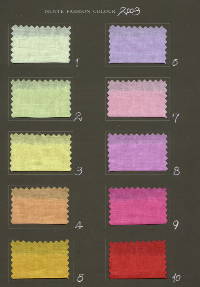
For
a bigger picture please click on above thumbnail
Applications
- Apparel
dresses, suits, skirts, jackets, pants, blouses, shirts,
children wear, mixed with cotton in knitted sweaters
- Home Fashion
curtains, draperies, upholstery, bedspreads, table linens,
sheets, dish towels
- Sewing threads
- Handkerchiefs
- Parachute fabrics
- Woven fire hoses
- Narrow weaving
- Canvas
- Filter cloth
- When used in a mixture with wool, shrinkage is reported to be greatly
reduced when compared with pure wool.
- Short waste fibers are used for the
production of high quality papers, such as bank notes & cigarette papers.
- As ramie takes up phosphorous, it is potentially useful for cleaning up
the Everglades. This region suffers
from a nutrient overload from the sugar industry.
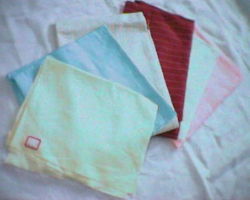
Ramie as a Blend
Ramie is most often blended (common is 55% ramie/45% cotton) with other fibers for its unique
strength and
absorbency, luster and dye-affinity. When blended with high-quality cotton it
offers increased luster, strength and color. When mixed with wool, ramie adds
lightness and minimizes shrinkage. When blended with rayon, it offsets the low
wet strength.
Care Recommendations for Ramie Fabrics
Care procedures prescribed on the care labels of ramie products vary. Items
of 100 percent ramie should not require special care. Generally, they may be
laundered or dry -cleaned depending on individual dyes, finishes and design
applications. High temperatures will not harm the fiber itself, making washing
in hot water and ironing at high settings possible; however, color retention,
shrinkage control or properties of blended fibers may dictate lower
temperatures. Recent laboratory testing done has
led to the conclusion that the best performance results when gentler or more
special handling is used in care. For example, fabrics retained the best color
and shape with the most wrinkle-free appearance when they were dry-cleaned.
Machine washing in cold water on gentle cycle with line drying was better
than machine washing in warm water with tumble drying on permanent press cool
down cycle. Hand washing in cool water with flat drying is the most strongly
recommended home care method for both knits and woven fabrics. The consumer who knows the strengths and
limitations of the fiber can receive maximum service and enjoyment from ramie
products.
When storing ramie or ramie blends, lay them flat. Ramie fibers are brittle
and tend to break. Avoid folding the garment or pressing sharp creases in woven
fabrics.

Ramie's role in farming systems
The following characteristics of the ramie crop would influence its
suitability in Australian farming systems:
- it is a perennial crop with a life of 6 to 20 years
- it is capable of producing high yields of biomass and if the harvesting
system involves total removal of this biomass, there would be a rapid
decline in soil fertility and
- ramie is subject to a number of pests and diseases, including nematodes.
|
| Processability
The crop
Ramie is a member of the Urticaceae or nettle family and is a hardy perennial
which produces a large number of unbranched stems from underground rhizomes. The stems of ramie grow to a height of 1 to 2.5 m. The crop is generally
propagated vegetatively, using rhizome or stem cuttings. Production begins to
decline once roots become overcrowded.
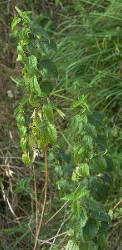
Harvesting
Ramie is normally harvested two to three times per year but under good
growing conditions can be harvested up to six times per year. Harvesting is done just before or soon after the onset of flowering, since
there is a decline in plant growth at this stage and maximum fiber content is
achieved. Stems are harvested by cutting just above the lateral roots or the stem can
be bent, to enable the core to be broken and the cortex can be stripped from the
plant in situ. Mechanical harvesters have been developed but are not used
commercially. After harvesting, stems are decorticated while the plants are fresh as the
bark gets harder to remove as the plant dries out. The bark ribbons are dried as
quickly as possible to prevent attack by bacteria or fungi.
The dry weight of harvested stem from both tropical and temperate crops
ranges from about 3.4 to 4.5 t/ha/year; a 4.5 ton crop yields about 1,600
kg/ha/year of dry non-de-gummed fiber. The weight loss during
de-gumming can be up to 25% giving a yield of de-gummed fiber of about 1,200 kg/ha/year.
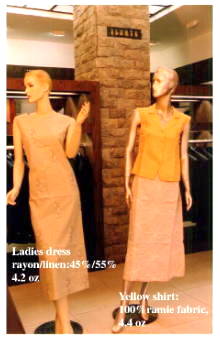
Extraction of fiber
Extraction of the fiber occurs in three stages.
- Firstly, the cortex or bark is removed, either by hand or machine, in a
process called de-cortication.
- The second stage involves scraping the cortex to remove most of the outer
bark, the parenchyma in the bast layer and some of the gums and pectins.
- The third stage involves washing, drying and
de-gumming of the residual cortex
material to extract the spinnable fiber. Details of the
de-gumming processes tend to be regarded as
commercial-in-confidence information
Ramie fiber
Ramie fiber is one of the premium vegetable fibers.
The ultimate fibers are exceptionally long and are claimed to be the longest
of vegetable origin, with one report claiming the fibers range up to 580 mm,
averaging about 125 mm. Ramie fiber is very durable, is pure white in colour and has a silky
luster.
For the hand spinner, ramie is treated similar to flax in that it can be
either wet or dry spun. A wet spun yarn will produce a smooth softer yarn with
high luster, while a dry spun yarn will feel hairier, have less luster and a
harsher handle. It can readily be blended with other fibers such as wool or
silk, although the length of ramie can sometimes cause difficulties.
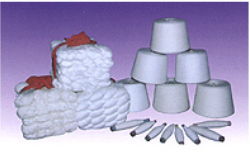
|
| Our
supplier partner
Hunan Isunte |
for more information on ramie in general please
click here
|



